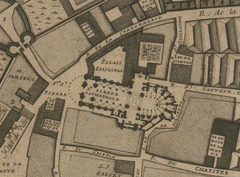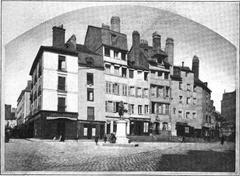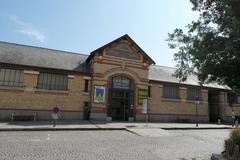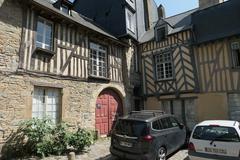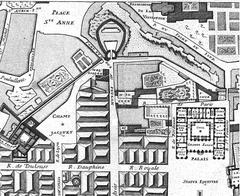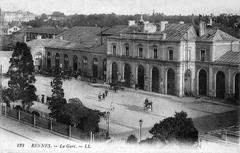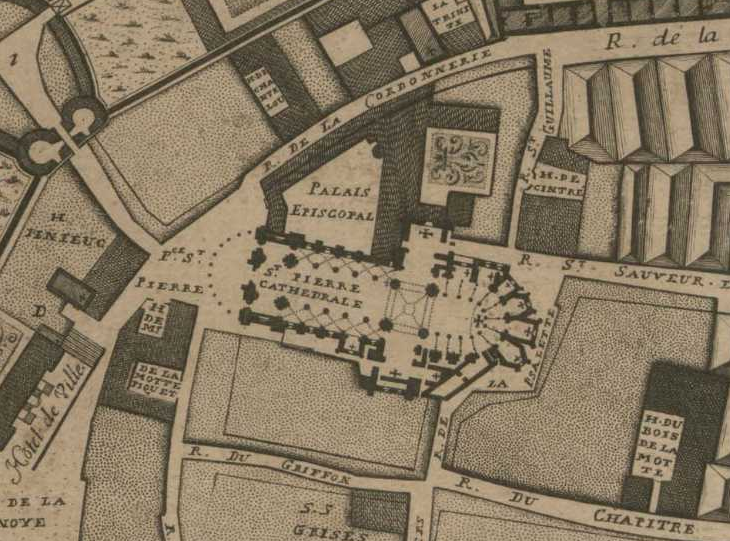
Comprehensive Guide to Visiting Cathédrale Saint-Pierre, Rennes, France
Date: 19/07/2024
Introduction
Nestled in the heart of Rennes, France, the Cathédrale Saint-Pierre stands as a beacon of historical, architectural, and cultural splendor. This monumental cathedral is a must-visit for history buffs, architecture enthusiasts, and curious travelers alike. Its origins date back to the 6th century, making it one of the oldest religious sites in Brittany. Over the centuries, Cathédrale Saint-Pierre has undergone numerous transformations, reflecting a fusion of Gothic and Neoclassical styles that make it unique among European cathedrals. This comprehensive guide delves into the rich history, architectural marvels, and essential visitor information to help you make the most of your visit to this iconic site. Whether you’re interested in its historical significance, stunning architectural features, or practical tips for your visit, this guide covers it all, ensuring an unforgettable experience at Cathédrale Saint-Pierre (source).
Table of Contents
- [History of Cathédrale Saint-Pierre](#history-of-cathédrale-saint-pierrehistory-of-cathédrale-saint-pierre)
- [Early Beginnings and Medieval Foundations](#early-beginnings-and-medieval-foundationsearly-beginnings-and-medieval-foundations)
- [Gothic Transformation](#gothic-transformationgothic-transformation)
- [Destruction and Rebuilding](#destruction-and-rebuildingdestruction-and-rebuilding)
- [19th Century Renovations](#19th-century-renovations19th-century-renovations)
- [Architectural Highlights](#architectural-highlightsarchitectural-highlights)
- [The Façade](#the-façadethe-façade)
- [The Nave](#the-navethe-nave)
- [The Choir and Apse](#the-choir-and-apsethe-choir-and-apse)
- [Special Features](#special-featuresspecial-features)
- [The Organ](#the-organthe-organ)
- [The Chapels](#the-chapelsthe-chapels)
- [The Crypt](#the-cryptthe-crypt)
- [Stained Glass Windows](#stained-glass-windowsstained-glass-windows)
- [The Bell Tower](#the-bell-towerthe-bell-tower)
- [The Sacristy](#the-sacristythe-sacristy)
- [The Cloister](#the-cloisterthe-cloister)
- [Visitor Information](#visitor-informationvisitor-information)
- [Visiting Hours](#visiting-hoursvisiting-hours)
- [Tickets and Guided Tours](#tickets-and-guided-tourstickets-and-guided-tours)
- [Travel Tips](#travel-tipstravel-tips)
- [Nearby Attractions](#nearby-attractionsnearby-attractions)
- [Key Historical Events](#key-historical-eventskey-historical-events)
- [FAQ Section](#faq-sectionfaq-section)
- [Conclusion](#conclusionconclusion)
History of Cathédrale Saint-Pierre
Early Beginnings and Medieval Foundations
The history of Cathédrale Saint-Pierre in Rennes dates back to the early medieval period. The first church on this site was constructed in the 6th century, making it one of the oldest Christian sites in Brittany. This initial structure was a modest wooden building, which was later replaced by a more substantial stone edifice in the 12th century. This Romanesque church served the local community for several centuries, reflecting the architectural styles and religious practices of the time.
Gothic Transformation
In the 15th century, the cathedral underwent significant changes. The Romanesque structure was deemed insufficient for the growing population and the evolving liturgical needs. Consequently, a Gothic-style reconstruction began, which was a common architectural trend across Europe during this period. The new design featured pointed arches, ribbed vaults, and flying buttresses, which were hallmarks of Gothic architecture. This transformation not only enhanced the aesthetic appeal of the cathedral but also improved its structural integrity.
Destruction and Rebuilding
The 18th century was a tumultuous period for Cathédrale Saint-Pierre. In 1720, a devastating fire ravaged much of Rennes, including the cathedral. The fire caused significant damage, necessitating extensive repairs and reconstructions. The rebuilding process was slow and arduous, reflecting the economic and social challenges of the time. By the late 18th century, the cathedral had been restored, but it retained scars from the fire, which are still visible today.
19th Century Renovations
The 19th century marked another significant phase in the cathedral’s history. Under the direction of architect Charles Millardet, extensive renovations were undertaken to restore and enhance the cathedral. These renovations included the addition of two new towers, which were completed in 1845. The towers, standing at 48 meters each, became iconic features of the Rennes skyline. The interior was also refurbished, with new altars, stained glass windows, and frescoes added to enrich the spiritual and aesthetic experience of visitors.
Architectural Highlights
The Façade
The façade of Cathédrale Saint-Pierre is a striking example of neoclassical architecture. The twin towers, added in the 19th century, frame the central entrance, which is adorned with intricate carvings and statues. The façade’s symmetry and grandeur reflect the architectural trends of the period and the cathedral’s importance as a religious and cultural landmark.
The Nave
The nave of the cathedral is equally impressive, featuring a series of Gothic arches and ribbed vaults. The high ceilings and expansive windows create a sense of openness and light, enhancing the spiritual ambiance of the space. The nave also houses several chapels, each dedicated to different saints and adorned with beautiful altarpieces and religious artifacts.
The Choir and Apse
The choir and apse are the focal points of the cathedral’s interior. The choir, where the clergy conduct religious services, is richly decorated with carved wooden stalls and intricate stonework. The apse, located behind the choir, features a stunning array of stained glass windows that depict scenes from the Bible and the lives of saints. These windows are masterpieces of medieval art, showcasing the skill and creativity of the artisans who created them.
Special Features
The Organ
One of the most notable features of Cathédrale Saint-Pierre is its grand organ, built by Aristide Cavaillé-Coll in 1874. Cavaillé-Coll was one of the most famous organ builders of the 19th century, and his instruments are renowned for their rich tonal quality and technical innovation. The organ at Cathédrale Saint-Pierre boasts 48 stops and 3,500 pipes, making it one of the largest in Brittany. It is housed in a magnificent case adorned with statues of angels playing musical instruments.
The Chapels
The cathedral contains several chapels, each with its own unique architectural and artistic features. The Chapel of the Blessed Sacrament, located on the south side of the nave, is particularly noteworthy. It features a stunning altarpiece by the Flemish painter Jacob Jordaens, depicting the Last Supper. The Chapel of Saint Anne, the patron saint of Brittany, is adorned with beautiful stained glass windows that narrate the life of the saint.
The Crypt
Beneath the cathedral lies a crypt that dates back to the 11th century. This Romanesque crypt is one of the oldest parts of the cathedral and serves as a reminder of its ancient origins. The crypt contains several sarcophagi and relics, including those of Saint Melaine, the first bishop of Rennes. The simple, austere design of the crypt contrasts with the grandeur of the cathedral above, providing a space for quiet reflection and prayer.
Stained Glass Windows
The stained glass windows of Cathédrale Saint-Pierre are a highlight of its architectural and artistic heritage. The windows in the nave and transepts date from the 19th century and were created by the renowned glassmaker Charles Champigneulle. These windows depict scenes from the Old and New Testaments, as well as the lives of saints and martyrs. The rose window in the west façade is particularly striking, with its vibrant colors and intricate tracery.
The Bell Tower
The bell tower of Cathédrale Saint-Pierre is an iconic feature of the Rennes skyline. The current tower, completed in 1704, replaced the original Gothic tower that collapsed in 1754. The tower houses a carillon of 50 bells, which are rung on special occasions and during religious festivals. The largest bell, known as “Marie,” weighs over 6 tons and produces a deep, resonant tone that can be heard throughout the city.
The Sacristy
The sacristy of the cathedral is a hidden gem, often overlooked by visitors. It contains a collection of liturgical vestments, chalices, and other religious artifacts, some of which date back to the 16th century. The sacristy is also home to a series of paintings by the Breton artist Jean-Julien Lemordant, depicting scenes from the life of Christ.
The Cloister
Although the original cloister of Cathédrale Saint-Pierre was destroyed during the French Revolution, remnants of it can still be seen in the cathedral’s courtyard. The cloister was once a place of contemplation and study for the cathedral’s clergy. Today, the courtyard is a peaceful oasis in the heart of the city, offering visitors a chance to relax and reflect.
Visitor Information
Visiting Hours
Cathédrale Saint-Pierre is generally open to visitors from 9 AM to 6 PM. However, it is advisable to check the official website for any changes in timings.
Tickets and Guided Tours
Admission to the cathedral is free, but guided tours are available for a fee. These tours are offered in multiple languages and provide in-depth historical and architectural insights. Tickets can be purchased online or at the entrance.
Travel Tips
- Dress Code - Modest attire is recommended, as it is a place of worship.
- Photography - Allowed, but without flash to preserve the artworks.
- Accessibility - The cathedral is wheelchair accessible, with ramps and designated areas for visitors with disabilities.
Nearby Attractions
While in Rennes, consider visiting other historical sites such as the Parlement de Bretagne, Parc du Thabor, and the Musée des Beaux-Arts. These attractions are within walking distance and offer a deeper understanding of the city’s rich cultural heritage.
Key Historical Events
- 6th Century - Initial wooden church constructed.
- 12th Century - Romanesque stone church built.
- 15th Century - Gothic reconstruction begins.
- 1720 - Fire devastates the cathedral.
- Late 18th Century - Restoration after the fire.
- 1845 - Completion of the twin towers.
- 19th Century - Extensive renovations under Charles Millardet.
FAQ Section
What are the visiting hours for Cathédrale Saint-Pierre?
The cathedral is generally open from 9 AM to 6 PM. Check the official website for any changes.
Is there an admission fee?
Admission is free, but guided tours are available for a fee.
Are there any special events hosted at the cathedral?
Yes, the cathedral hosts various religious ceremonies, concerts, and cultural events throughout the year. Check the official website for the event calendar.
Conclusion
Cathédrale Saint-Pierre in Rennes stands as a testament to the city’s rich history and architectural prowess. Whether you are a history enthusiast, an architecture aficionado, or a spiritual seeker, this cathedral offers something for everyone. Don’t miss the opportunity to explore this remarkable landmark and delve into its fascinating past. For more information and to plan your visit, check out the official website of the Archdiocese of Rennes.
References
- Exploring Cathédrale Saint-Pierre in Rennes - History, Architecture, and Visitor Information, 2024, source
- A Complete Guide to Visiting Cathédrale Saint-Pierre in Rennes - History, Tickets, and Tips, 2024, source
- Exploring Cathédrale Saint-Pierre in Rennes - History, Architecture, and Visitor Tips, 2024, source
